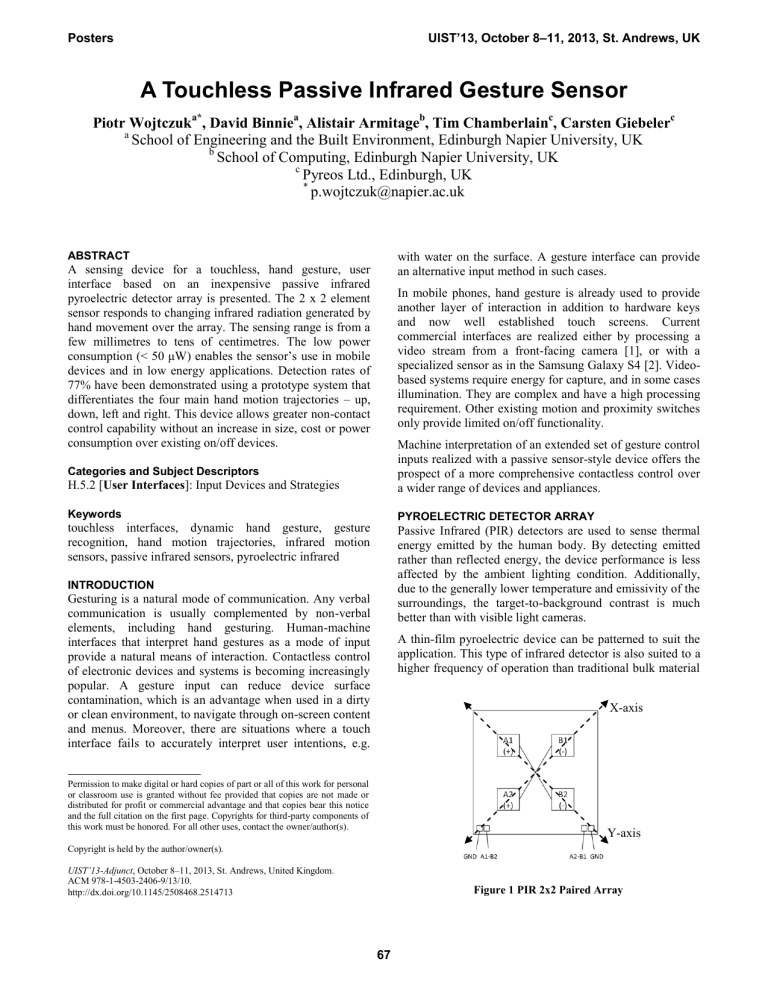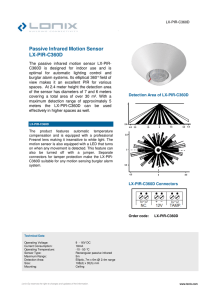
Posters UIST’13, October 8–11, 2013, St. Andrews, UK A Touchless Passive Infrared Gesture Sensor Piotr Wojtczuka*, David Binniea, Alistair Armitageb, Tim Chamberlainc, Carsten Giebelerc a School of Engineering and the Built Environment, Edinburgh Napier University, UK b School of Computing, Edinburgh Napier University, UK c Pyreos Ltd., Edinburgh, UK * p.wojtczuk@napier.ac.uk with water on the surface. A gesture interface can provide an alternative input method in such cases. ABSTRACT A sensing device for a touchless, hand gesture, user interface based on an inexpensive passive infrared pyroelectric detector array is presented. The 2 x 2 element sensor responds to changing infrared radiation generated by hand movement over the array. The sensing range is from a few millimetres to tens of centimetres. The low power consumption (< 50 μW) enables the sensor’s use in mobile devices and in low energy applications. Detection rates of 77% have been demonstrated using a prototype system that differentiates the four main hand motion trajectories – up, down, left and right. This device allows greater non-contact control capability without an increase in size, cost or power consumption over existing on/off devices. In mobile phones, hand gesture is already used to provide another layer of interaction in addition to hardware keys and now well established touch screens. Current commercial interfaces are realized either by processing a video stream from a front-facing camera [1], or with a specialized sensor as in the Samsung Galaxy S4 [2]. Videobased systems require energy for capture, and in some cases illumination. They are complex and have a high processing requirement. Other existing motion and proximity switches only provide limited on/off functionality. Categories and Subject Descriptors H.5.2 [User Interfaces]: Input Devices and Strategies Machine interpretation of an extended set of gesture control inputs realized with a passive sensor-style device offers the prospect of a more comprehensive contactless control over a wider range of devices and appliances. Keywords PYROELECTRIC DETECTOR ARRAY touchless interfaces, dynamic hand gesture, gesture recognition, hand motion trajectories, infrared motion sensors, passive infrared sensors, pyroelectric infrared Passive Infrared (PIR) detectors are used to sense thermal energy emitted by the human body. By detecting emitted rather than reflected energy, the device performance is less affected by the ambient lighting condition. Additionally, due to the generally lower temperature and emissivity of the surroundings, the target-to-background contrast is much better than with visible light cameras. INTRODUCTION Gesturing is a natural mode of communication. Any verbal communication is usually complemented by non-verbal elements, including hand gesturing. Human-machine interfaces that interpret hand gestures as a mode of input provide a natural means of interaction. Contactless control of electronic devices and systems is becoming increasingly popular. A gesture input can reduce device surface contamination, which is an advantage when used in a dirty or clean environment, to navigate through on-screen content and menus. Moreover, there are situations where a touch interface fails to accurately interpret user intentions, e.g. A thin-film pyroelectric device can be patterned to suit the application. This type of infrared detector is also suited to a higher frequency of operation than traditional bulk material X-axis Permission to make digital or hard copies of part or all of this work for personal or classroom use is granted without fee provided that copies are not made or distributed for profit or commercial advantage and that copies bear this notice and the full citation on the first page. Copyrights for third-party components of this work must be honored. For all other uses, contact the owner/author(s). Y-axis Copyright is held by the author/owner(s). UIST’13-Adjunct, October 8–11, 2013, St. Andrews, United Kingdom. ACM 978-1-4503-2406-9/13/10. http://dx.doi.org/10.1145/2508468.2514713 Figure 1 PIR 2x2 Paired Array 67 Posters UIST’13, October 8–11, 2013, St. Andrews, UK have been used as the estimated parameters for development and an extended study is currently being undertaken. DIRECTION DISCRIMINATION The sensor output sampled at 68.36 Hz produces an amplitude-time response characteristic to the motion trajectory composite along a pair axis (i.e. sensor diagonal) for each pair. A Negative-then-Positive occurs as a response to one direction swipe, and Positive-then-Negative results from opposite direction of movement (Figure 2, bottom). Target plane Aperture plane Ah - + Pixel plane The signal is analysed and a decision about the motion direction is made. The direction discrimination currently is limited to movements that are close to parallel to either axis, therefore producing four possible direction outputs. The captured sample data shows that there is sufficient information in the signal that can lead to a much better direction resolution. Further, a high-speed camera study combined with the sensor readout is underway to establish the limits of such processing. CONCLUSION AND FURTHER WORK The current working evaluation of the prototype device gives detection rates of 77% (number of gestures detected correctly out of all gestures produced). 86% of the detected gestures were of the correct direction. The system was trialled indoors and outdoors and the recorded sensor signals as well as the actual detection give promising results. Current focus of the study is on establishing the limits of operation against simultaneously video-recorded ground-truth. Figure 2 Spatial discrimination along a detection axis – pixel pair cross section (top) and angular response measurement of a pixel pair along its axis (bottom) sensors. Here, an array of four elements, connected in oppositely coupled diagonal pairs, is used, as shown in Figure 1. We have previously also presented a 4 x 4 array used in a similar application [3, 4]. REFERENCES 1. E. Woyke, Texas Instruments Sees Big Market For Smartphone Gesture Recognition - Forbes, http://www.forbes.com/sites/elizabethwoyke/2011/10/31 /texas-instruments-sees-big-market-for-smartphonegesture-recognition/, 2011, accessed: 05/2013. SPATIAL DISCRIMINATION An infrared sensing array alone does not have spatial resolution – all elements react to a stimulus effectively in the same way. By applying an aperture the field-of-view of each pixel is restricted and will thus be sensitive to a different volume of object space. A method of using a pyroelectric sensor array with inversely coupled pixel pairs to detect direction and speed of motion as a basis for a people counting system was patented in 1994 [5]. 2. Samsung Galaxy S4 Product Page, Specification: Gesture Sensor, http://www.samsung.com/global/microsite/galaxys4/, accessed: 06/2013. 3. P. Wojtczuk, A. Armitage, T. D. Binnie, T. Chamberlain, PIR Sensor Array for Hand Motion Recognition, in: The Second International Conference on Sensor Device Technologies and Applications, Nice/Saint Laurent du Var, France, 99-102, 2011. Here, a similar principle allows multiple directions to be detected using two pixel pairs, as illustrated in Figure 2. 4. P. Wojtczuk, A. Armitage, D. Binnie, T. Chamberlain, Recognition of Simple Gestures Using a PIR Sensor Array, Sensors & Transducers Journal 14 (1) (2012) 8394. GESTURE INPUT CHARACTERISTICS A 200 Frames per Second video camera mounted above a desk, looking vertically down on the surface with 1 cm marked scale was used to record footage of participant hand and finger swipes. Based on an in-house study on a range of participants, the limits of velocity were found to be <12 m/s for a hand swipe and <5 m/s for a finger flick. These figures 5. W. Lee, Method and apparatus for detecting direction and speed using PIR sensor, U.S. Patent No. 5,291,020. 1 Mar. 1994 68


